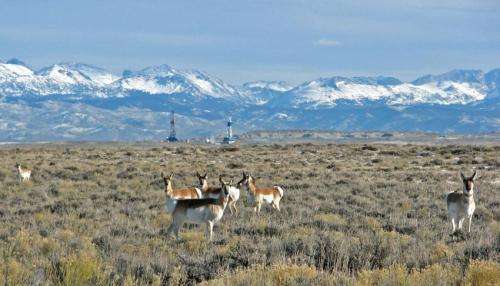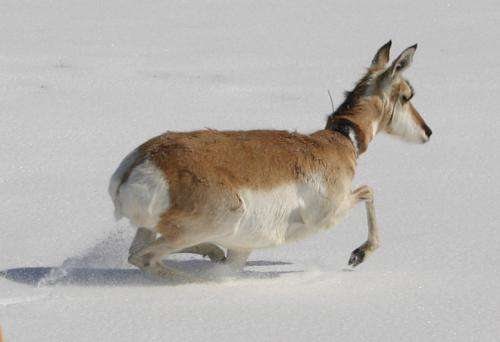Study identifies gauntlet of obstacles facing migrating pronghorn in greater Yellowstone

One of North America's last remaining long-distance land migrations, better known as the Path of the Pronghorn, is being threatened by a mosaic of natural gas field development, highway traffic, and fencing in the upper Green River Basin, according to the Wildlife Conservation Society. WCS scientists used a model traditionally applied to identify resource related stopovers for migrating animals in order to identify impediments to migration of pronghorn.
The long-distance travels of the fleet-footed pronghorn through this part of the Greater Yellowstone Ecosystem was the focus of a high-tech effort to identify impediments inside the animal's migratory corridors based on how pronghorn behave when confronting a potential obstacle.
The study titled "Identifying Impediments to Long-Distance Mammal Migrations" appears in the online version of the journal Conservation Biology. The authors are: Renee Seidler, Ryan Long, Joel Berger, Scott Bergen, and Jon Beckmann.
"Long-distance mammal migration is in serious peril around the globe. Highways with dense traffic and housing developments might present obvious obstacles in need of mitigation, but in some areas, addressing threats requires more than simple observation and intuition. Insight into animal behaviour using technical applications can provide precise understanding of the mechanisms behind the animal movement," said WCS researcher Renee Seidler, lead author of the paper. "Our findings of how pronghorn move through the landscape give a solid foundation from which to formulate effective solutions for threatened migrations."
The pronghorn of the Greater Yellowstone Ecosystem have already been the focus of several efforts to minimize the effects of development on their migration, which can extend over 170 miles annually between the upper Green River Basin and the Jackson Hole area and Grand Teton National Park in Wyoming. In 2008, part of this migration route was afforded protection by the Bridger-Teton National Forest. In 2012, a series of over- and underpasses with guide fencing were constructed by the Wyoming Department of Transportation to facilitate the movements of pronghorn and other wildlife across US Highway 191 at Trapper's Point. The migration route, however, still remains under threat from other impediments such as development, fences, and traffic on roads along unprotected stretches.

The latest research effort elucidated how pronghorn were reacting to environmental variables along the migration corridor. From 2005 to 2009, the scientists captured 250 female pronghorn antelope with nets deployed from helicopters during the winter months; the animals were then fitted with GPS-collars and released, allowing scientists to pinpoint the animals eight times a day. The team also conducted a detailed analysis of the migratory landscape via satellite imagery, including two gas fields in various stages of development.
The researchers then used a two-stage analysis to determine if pronghorn used stopover sites to gather resources or if the stopovers were generated by a perceived impediment. The collared pronghorn spent 78 percent of their time in stopovers during the spring migration. During their migration, they avoided the most densely developed natural gas field areas, in accord with a previous WCS study of pronghorn habitat use on winter range in the region. Highways presented another difficulty for migrating pronghorn, especially along Highway 191 north of Farson, Wyoming where the road is bordered by a woven-wire fence (an impenetrable barrier for pronghorn).
The team discovered that pronghorn that approached migration bottlenecks with high traffic volumes, fences, and land development—such as those along US Highway 191—used a stopover before crossing the highway and, notably, did not select high quality forage on either side of the highway. Additionally, they avoided shrub habitat—an important food resource for pronghorn—when approaching the highway, but then began selecting for shrubs again after crossing. By contrast, pronghorn migrating across US Highway 189, where bottlenecks were absent, traffic densities were lower, and fences had been modified to accommodate wildlife, did make use of high quality food sources on both sides of the road. The effects of bottlenecks on pronghorn movements and foraging behaviours, the authors maintain, could have a significant impact on the fitness of migrating animals.
"The insights provided by this study will help us build on the successes of recently constructed wildlife crossing structures around Trapper's Point." said Dr. Jon Beckmann, Connectivity Initiative Coordinator of WCS's North America Program and lead on the pronghorn project. "A better understanding of how pronghorn use habitat during their migrations, and the factors that may impact their ability to move through the landscape, will enable state and federal agencies and conservation groups to ensure a future for North America's fastest land mammal."
More information: Conservation Biology, onlinelibrary.wiley.com/doi/10 … 1111/cobi.12376/full
Journal information: Conservation Biology
Provided by Wildlife Conservation Society



















